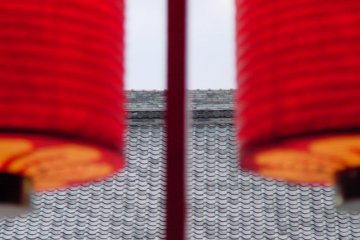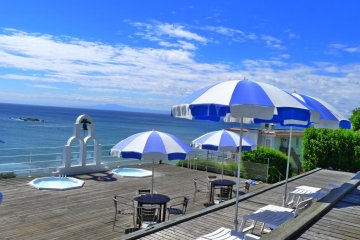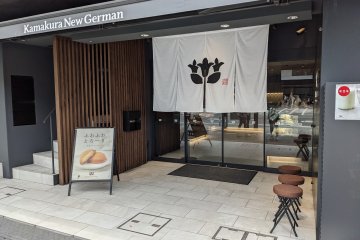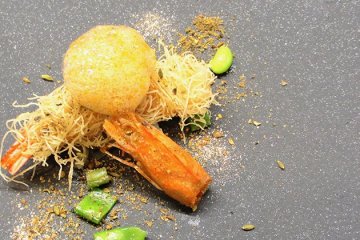
วัด Hongaku-ji แห่งคามาคุระ
Larry Knipfingดินเพียงไม่กี่นาทีจากสถานีคามาคุระ วัดฮอนกะกุ-จิ (Hongaku-ji) เป็นวัดที่ควรค่าแก่การแวะชมใมระหว่างทางไปวัดเมียวฮอน-จิ (Myohon-ji) วัดแห่งนี้เป็นวัดสังกัดนิกายนิชิเร็น

Hongakuji Temple (本覚寺) is dedicated to Ebisu, part of the Kamakura seven deities of good luck. The temple was founded by Ashikaga Mochiuji in 1436.

ดินเพียงไม่กี่นาทีจากสถานีคามาคุระ วัดฮอนกะกุ-จิ (Hongaku-ji) เป็นวัดที่ควรค่าแก่การแวะชมใมระหว่างทางไปวัดเมียวฮอน-จิ (Myohon-ji) วัดแห่งนี้เป็นวัดสังกัดนิกายนิชิเร็น

ไทเซน-คาคุเป้นโรงเตี๊ยมอายุ 100 ปี และอยุ่ติด ๆ กับวัดฮาเสะ คันนอนเลย บริการของที่นี่จะเป็นประสบการณ์อันน่าประทับใจของคุณที่คามาคูระ

ทานอาหารกลางวันที่ The Scapes ลิ้มลองสลัดผัก สเต็กเนื้อนุ่ม และของหวานอร่อยๆ ท่ามกลางบรรยากาศและทัศนียภาพอันงดงาม

ถ้าคุณมาที่ฮานามะ โฮเต็ล โอโตว่า โนะ โมริ วิธีที่ดีที่สุดที่คุณจะใช้เวลาอาจจะเป็นการที่ไม่ทำอะไรเลย แค่พักผ่อนอย่างเดียว ที่นี่คุณสามารถหาบรรยากาศของรีสอร์ทอย่างแท้จริงได้!

ลิ้มรสหมูทอดที่มีชื่อเสียงของอะราทามา และคุณจะตกหลุมรักกับรสชาติอันสดใหม่ ที่นี่ไม่ได้มีเพียงเมนูทงคัตสึเท่านั้น อย่าลืมลิ้มลองอาหารเมนูอื่นๆ ของอะราทามา เช่น มอซซาเรลลา เมนชิ คัตสึ และครีม โคร็อกเกะ

ค้นพบรสชาติที่ชาวบ้านคามาคุระหลงใหล ใหม่เค้กสปันจ์คัสตาร์ดเนื้อนุ่มของเยอรมันเป็นของหวานที่จะสร้างความประทับใจอย่างแน่นอน รสคัสตาร์ดคาราเมลเป็นที่นิยมอย่างมากในหมู่นักท่องเที่ยว

ที่ Nature et Sens ร้านอาหารฝรั่งเศสสุดสร้างสรรค์ ลูกค้าจะได้รับประทานอาหารมื้ออร่อย พร้อมประสบการณ์ทางประสาทสัมผัส โดยที่นี่ใช้วัตถุดิบตามฤดูกาลและผลผลิตของคามาคุระเป็นส่วนประกอบสำคัญของอาหารที่สวยงามน่าอัศจรรย์เหล่านี้ เพลิดเพลินกับไวน์สักแก้วพร้อมมื้ออาหารของคุณที่มีให้เลือกสรรอย่างหลากหลาย เพื่อประสบการณ์ที่ดีที่สุด

Yakumo Shrine, also called Yakumo Jinja, was established around 1082 by Yoshimitsu Minamoto—a Minamoto clan samurai during the Heian Period—and is believed to be the oldest talismanic shrine in Kamakura. It is located in the Omachi neighborhood and is said to ward off bad luck. Yoshimitsu Minamoto founded the shrine to help protect the people of Kamakura against the many epidemics that had taken hold of the area. The shrine represented a branch of Gion Shrine (modern day Yasaka Shrine) in Kyoto, which was known for its protection against illnesses. When the severity of Kamakura’s epidemics lessened in 1084, the shrine became a popular spot to repel bad luck. Today, the shrine is a small, quiet, and off-the-beaten-path spot to pray for good luck. Enjoy the peaceful grounds and be sure to collect a red Goshuin stamp at the shrine’s office to commemorate your visit.

Myohonji, located in the heart of Kamakura, is one of the oldest Nichiren-sect temples of Japanese Buddhism. Despite its city location, the temple is renowned for its tranquil atmosphere and lush encircling nature. It also tends to be less touristy than other temples in the area. Myohonji was founded in 1260 by Hiki Yoshimoto after he encountered the Buddhist priest and philosopher Nichiren Shonin in Kamakura. The site of the temple was previously home to the Hiki clan, before they were defeated by the Hojo clan in the early 1200s. Hiki Yoshikazu donated his home to Nichiren Shonin for the souls of his fallen clan, which later grew to be Myohonji. Some notable structures include Soshido, Myohonji’s largest temple building, Nitenmon gate, a beautiful inner gate, and a bronze statue of Nichiren. Enjoy the temple grounds in all seasons with spring cherry blossoms, verdant summer foliage, fiery autumn maple and ginkgo leaves, and winter plum blossoms.

Tsurugaoka Hachimangu Shrine is arguably the most important shrine in Kamakura and is located roughly in the center of the city. The shrine was originally founded in 1063 by Minamoto Yoriyoshi, the head of Japan’s Minamoto Clan, and was later moved in 1180 to its current location by Minamoto Yoritomo, the founder and first shogun of the Kamakura shogunate. This relocation marked the start of samurai society and Kamakura as a spiritual and social center of Japan. This rich history and culture is still present in Kamakura today. The shrine is dedicated to Hachiman, the guardian deity of samurai and the Minamoto Clan. Hachiman is worshiped for good fortune in warfare. The long pathway to the shrine runs through Kamakura City and is marked by multiple red torii gates, showing an interconnectedness between spirituality and urban life. Upon entering the shrine grounds, you will see two ponds on either side of you. The pond on the left represents the Minamoto clan, and the one on the right represents the Taira Clan (Minamoto’s rival). The Taira pond purposefully has four islands in it, which symbolizes the bad blood between the clans as four can be pronounced the same as “death” in Japanese. Beside the Minamoto pond is a beautiful peony garden that is open in winter and spring when the flowers are in full bloom. Past the ponds you will come across the mai-den, which is located at the base of the stairs to the main hall. This vibrant red building is used as a stage for music and dance performances throughout the year’s festivities. Atop the wide staircase is the main hall. This traditionally designed structure features a red facade with gold-and-green detailing and is a commanding sight due to its massive size. Beside the main hall is a treasure hall that displays historical artifacts such as swords and masks. The grounds are also home to numerous smaller buildings and shrines, most notably Wakamiya and Maruyama Inari Shrine, which, along with the main hall, are nationally important cultural properties. Tsurugaoka Hachimangu hosts numerous events throughout the year. One of the shrine’s most popular festivals occurs from September 14th to 16th and features yabusame horseback archery. The shrine is also one of Japan’s most popular spots for hatsumode, which is the first shrine visit of the year.